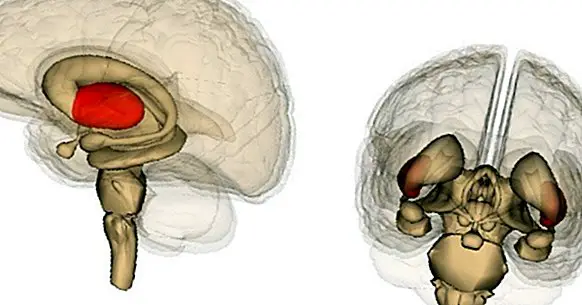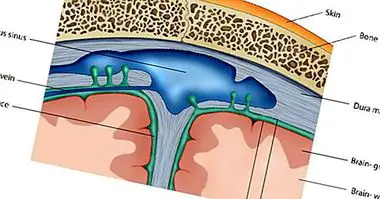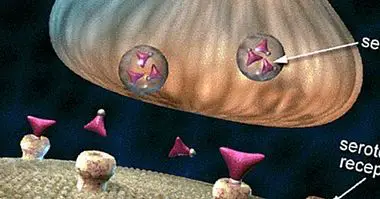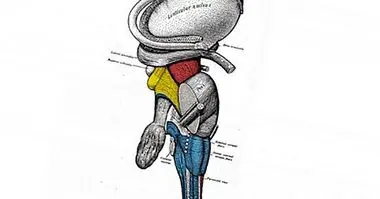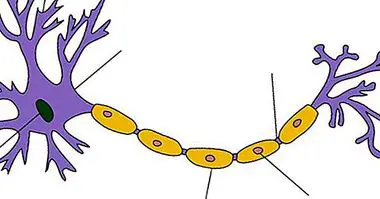Thalamus: anatomy, structures and functions
The thalamus It is one of the most important parts of the brain. Not only is it one of the largest encephalic structures, but it is also located in the very center of the brain, as its name reflects, which comes from the Greek word thalamos (or "internal camera").
By occupying so much and being so well connected with the other parts of the brain, the thalamus intervenes in a large number of mental processes that shape our way of perceiving things and acting on the environment that surrounds us ... even if we do not realize it.
What is the thalamus?
The thalamus is basically a set of gray substance (bodies of neurons) formed by two egg-shaped encephalic structures that are below the cerebral cortex. These structures are located next to each other, and in addition to having the same shape and size they have a symmetrical arrangement, as do the two cerebral hemispheres that cover them. They communicate with each other through a kind of bridge that holds them together and that is called inter-body connection.
The thalamus is part of an area called diencephalon . The diencephalon is located between the cerebral cortex (and all the lobes of the brain) and the upper part of the brainstem. In turn, the diencephalon is composed, by the thalamus, the hypothalamus (located just below the first) and some other smaller structures.
In addition, the thalamus has a symmetrical shape and being located just below the space that separates the two cerebral hemispheres, it has an outlet on both sides of the brain. To see how it interconnects with these parts, we can take a look at the structures of the thalamus and the types of neurons in it.

The structures of the thalamus
The thalamus is basically a stacking of neuron bodies, that is, a structure of gray matter, just like the cerebral cortex. But Within this set of neuronal groups we can distinguish a series of nuclei of the thalamus :
- Specific connection cores . These send sensory information to specific areas of the cerebral cortex that are specialized in working with that particular type of data coming from a specific sense.
- Nonspecific connection cores . They send information to very wide areas of the cerebral cortex, without discriminating by specializations.
- Association cores . They are part of an information circuit that communicates the cerebral cortex with subcortical structures.
The neurons of the thalamus
The thalamus is composed of many other specialized substructures, but all of them are, after all, neurons and glial cells . Like any other part of the brain, the thalamus only has reason to be if it is connected to other areas of the nervous system, and this is reflected in the type of neurons that compose it. In the distribution of these it is noted that they are associated with many other bundles of neurons that come from many parts of the central nervous system.
From the functional point of view, the classes of thalamus neurons are the following :
- Local interneurons . These nerve cells are basically responsible for making the information that comes from other parts of the nervous system is processed in the thalamus, transforming it into a new series of data. Therefore, its main function is to send nerve impulses to other interneurons of the thalamus. They account for approximately 25% of the thalamus neurons.
- Projection neurons . These nerve cells are responsible for sending information out of the thalamus, into the cerebral cortex. They are 75% of thalamic neurons.
The functions of the thalamus
We have seen that the thalamus is very well connected, but its role is not to be a simple bridge of communication between relevant parts of the brain. The thalamus itself is a structure that plays an active role in the processing of information that comes from other areas. But... What are the functions that this brain structure plays?
1. Integration of sensory data
The most well-known and studied function of the thalamus is that of being one of the first stops in the brain for the information that reaches us through the senses , with the exception of smell.
The thalamus processes this sensory information, discards the parts that are not too important and sends the final result to the cortex of the brain, where this information will continue to be processed.
Thus, it facilitates the integration of sensory information to pass the raw data to relatively complex information units and capable of sustaining a meaning for us.Anyway, we must be clear that this process not only takes place in the thalamus, but in it involved several networks of neurons distributed by virtually the entire brain.
2. The sleep-wake cycle
The thalamus, like its younger brother the hypothalamus, intervenes when it comes to regulating the rhythm with which the sensation of sleep comes and goes. This function, besides being fundamental to regulate all the nervous activity in general, is also related to the following.
3. Attention and awareness
Recent research indicates that the thalamus could have a very important role in the appearance of consciousness and everything that is related to it ; from the ability to think about one's thoughts, to the use of language, through the ability to focus attention on specific information according to the objectives that are held at each moment.
However, it is important to note that those processes related to conscious states are not consciousness itself, although they appear in parallel. We can not focus our attention on anything when we do not realize that we exist, and we can not talk or reflect; but when we are conscious, there are aspects of attention and language that are beyond consciousness.
In addition, all these complex mental processes related to abstract thinking require the participation of many areas of the brain, not just the thalamus ; This part of the diencephalon is a necessary but insufficient component when it comes to making thought, attention and language take place (something that can be said about practically all parts of the brain, because they all work in an interconnected way).
As the thalamus is so well connected to many areas of the cortex at the same time, it may be able to intervene in the synchronization of neural activity necessary for the level of consciousness to be maintained.
4. The regulation of emotions
The thalamus is not only connected to circuits that carry sensory information, but also it also interacts with neural pathways that directly participate in the appearance of emotional states . Not in vain the thalamus is surrounded by the limbic system.
Thus, the thalamus integrates these two pathways and works together these two types of information, causing emotions to affect the perceived and vice versa. In addition, it receives information from the hypothalamus, which in turn intervenes directly in the regulation of emotions and the segregation of different types of hormones in the bloodstream.
conclusion
The thalamus is one of the largest parts of the brain and, in addition, it seems to have a role in a multitude of functions that neither look too much nor have much to do with each other at a first glance.
However, this is a reflection of the very functioning of the nervous system, in which all the time, regardless of whether we sleep or are awake, a multitude of processes are being carried out in parallel and at the same time in a coordinated manner.
It also has a very relevant role in the appearance and maintenance of brain activation states responsible for keeping us aware of our own existence and what happens around us. This has made the thalamus has come to be considered "the switch of consciousness" .
However, the thalamus itself is not the part of the brain in which consciousness "resides". To suppose this would be like thinking that inside our head there is a pixie with self-awareness that is surrounded by non-conscious matter just as the pilot of an airplane would; that is, it would make us fall into the dualism of philosophers like René Descartes.
It is currently understood that consciousness is the result of the activity of various parts of the brain (among which the thalamus would stand out) working with each other at high speed and in a coordinated manner, and therefore this mental state can not be reduced to a single structure .
Bibliographic references:
- Boutros, N. J. (2008). The thalamus. Clinical EEG and Neuroscience, Vol.39 (1), p.IV
- Perea-Bartolomé. M. V. and Ladera-Fernández, V. (2004). The thalamus: neurofunctional aspects. Journal of Neurology, 38 (7), pp. 697 - 693.
- Sherman, S. (2006). "Thalamus." Scholarpedia1 (9): 1583

